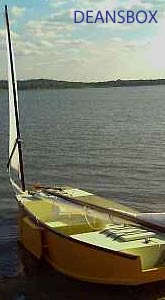
 Custom Search
|
| boat plans |
| canoe/kayak |
| electrical |
| epoxy/supplies |
| fasteners |
| gear |
| gift certificates |
| hardware |
| hatches/deckplates |
| media |
| paint/varnish |
| rope/line |
| rowing/sculling |
| sailmaking |
| sails |
| tools |
| join |
| home |
| indexes |
| classifieds |
| calendar |
| archives |
| about |
| links |
| Join Duckworks Get free newsletter CLICK HERE |
|
|
| July Reports |
Remarkably Few Boats in ScotlandEven so, I did get a picture of a sailboat. Click only if you are interested in seeing Part 1 of my trip to Scotland. We took over 900 pictures between the 2 of us. There's about 50 in this one, the rest will be forthcoming. This might be a good time to remind you the 'Duckers' and I are doing fund raising for the LiveStrong foundation. Donations are appreciated. Andrew Linn Bringing Boats to LifeI have no affiliation with them. I just love their work and am a card carrying member. Occasional they release a video into the wild and let us share. Here's one from my neck of the woods. Bringing Boats to Life — An Epic Launch at Rockport Marine - OffCenterHarbor.com Jed Another Oz Goose ReportThis time in very light wind. Another article on Hokulea.
MIK Storer Red ScampThe Red Scamp sailing in Lake Bastrop on a windy day, just up the road from me. Two of my favorite people in that boat. Mike Monies and Chuck Leinweber. The video production is outstanding. JIB Worldwide GIS VideoI posted the final cut of the worldwide GIS video on Youtube. Daniel ALFBuilding an ALF for a customer. If interested, take a look! John GISPossibly the most famous GIS. There are pages and pages of sailiing reports, camping around Maine, photo and building info on Goat Island Skiff Amateur Style. This boat has been really well used. Read more... MIK Storer Bolger Windsprint
Your readers may be interested in my Bolger Windsprint. Having owned a Sunfish sailboat, I was impressed with the simplicity and performance on the lateen sail on the boat. So I modified the Windsprint to use a Pryde Sunfish sail. Other modifications are to the rudder, decks and flotation and a 1 3/4" full length keel. This makes the boat track like a train while rowing but slow in turns under sail, so I simply gybe. The boat sails amazingly well and is fast and stable. Great for a senior non-swimmer! I and any passengers ALWAYS wear life jackets. The boat is 12 years old now and still in great shape. It was built with a 3/8" bottom and 1/4" sides, all marine plywood with a fiberglassed bottom. The boat is painted with Behr Porch and Floor paint and has been a work in progress since her inception. The boat has become an exercise in simplicity. Jim Gooley Duo
Here are todays first sailing photos. I am sailing with the full "training wheel" set up. I'm going to remove them tomorrow - too boring, although very stable and safe. Almost made 5 knots though (4.8). Richard Woods of Woods Designs sailing catamaran designers Richard's Designs in the Duckworks Store. BoatUS.com/Hurricanes Has Boat, Marina Preparation Tips Keeping Boats in Place Bolsters Community Resiliency ALEXANDRIA, Va., May 27, 2014 – In the weeks after Superstorm Sandy struck Staten Island’s Great Kills Harbor, orphaned boats littering city streets blocked traffic and interfered with access by emergency vehicles, and sailboat masts snagged in overhead wires delayed the return of much-needed electrical power. Keeping boats contained in Sandy would have facilitated recovery efforts on every front. “The more boats you have in the way of recovery or needing salvage after a hurricane, the longer the delay in returning to normal,” said BoatUS Vice President Public Affairs Scott Croft. With the Atlantic Hurricane season starting Sunday, June 1, BoatUS offers boat owners, public and private marina operators, boat club and community resiliency managers free information on preparing boats, marinas and boat clubs at the online BoatUS Hurricane Tracking and Resource Center (BoatUS.com/hurricanes). Included are: 1. The easy-to-download, print, post and share BoatUS Tips for Protecting Boats in Hurricanes (www.BoatUS.com/hurricanes/tipsheet) is a basic two-page primer on hurricane prep for all boaters in a hurricane state. 2. Boater’s Guide to Preparing Boats and Marinas for Hurricanes (www.BoatUS.com/hurricanes/assets/pdf/swhurr_prep_guide.pdf) is the boaters guide on Hurricane prep 101, and has more details on protecting your boat and a marina. 3. What Works: A Guide to Preparing Marinas, Yacht Clubs and Boats for Hurricanes (www.BoatUS.com/hurricanes/assets/pdf/hurr_prep_guide.pdf) is a helpful resource for community resiliency managers, local government, marina and boat club staff that focuses on facilities. Local emergency managers, marina or club fleet operators can also download a sampling of marina hurricane preparation plans to see how their local marinas compare, learn about the value of strapping down boats stored ashore, and view features on why some marinas fare better than others. When a storm approaches, BoatUS.com/hurricanes also has up-to-the-minute storm tracking tools with live satellite images, as well as checklists for what to do before and after a hurricane strikes. Much of the information provided comes from BoatUS and its Marine Insurance Catastrophe (CAT) Team, a national leader in hurricane preparedness that has over 30 years of storm salvage experience. Go to BoatUS.com/hurricanes for more. Gary Good Samaritans Tossing A Towline: For Free or for Money? Tips on How to Help a Boater in Need of a Tow ALEXANDRIA, Va., June 5, 2014 -- Tossing a towline to a disabled boat and bringing it back safely to the launch ramp is a time honored act of kindness that recreational boaters have always done for each other. But what happens if the Good Samaritan tossing the line decides to charge for their services? Is there much of a difference between a Good Sam looking for a little extra gas money and a professional towing service charging for on water towing services? According to Boat Owners Association of The United States, once money changes hands for a routine tow, a Good Sam is opened up to a world of liability they may not want in their lap. Accepting money also requires a mariner’s credential – such as a Captain’s license – and would require commercial registration of the towing vessel. While Boat Owners Association of The United States offers the largest on water towing fleet in the US, it understands the law of averages: There are 12 million registered recreational vessels in the nation and some are bound to breakdown. In 2013, the BoatUS 24-hour dispatch centers alone received 70,000 requests for on water assistance, and the boat owners group says there are likely thousands of Good Samaritans each year lending a helping hand to other boaters. Said BoatUS Towing Services Vice President Adam Wheeler, “Towing is a job best left for the professionals, but many boaters often find themselves in areas where professional assistance is not available." While Good Samaritan laws vary from state to state, they generally provide that anyone who renders aid to injured persons is not liable for any damages if the assistance is provided in good faith, without compensation or other consideration, and without gross negligence. And in fact, in some states, failing to render emergency assistance to the persons involved can also possibly put you in trouble with the law – but there is no duty to require a Good Sam to tow or “save” a boat. For federally designated ‘navigable’ waterways, federal law trumps state law and says that the master or individual involved in rendering assistance “is not liable for damages as a result of rendering assistance or for an act or omission in providing or arranging salvage, towage, medical treatment or other assistance when the individual acts as an ordinary, reasonable and prudent individual would have acted under the circumstances.” “A boater who does not charge for rendering assistance is protected under the Good Samaritan laws for any damages or injuries that might occur during the tow,” said Wheeler. “If money exchanges hands and someone gets injured or the disabled boat gets damaged, you’re no longer considered a Good Sam and would be opening the door to much more liability. You may be even personally liable, depending on your insurance policy – if you have one. It’s just something else to think about before throwing a towline and asking for money. A commercial towing company carries insurance to cover those types of mishaps.” For boaters committed to being a Good Samaritan, BoatUS has these tips:
“It’s always good to help out a fellow boater because sooner or later, it could be you asking for a tow back to the dock,” said Wheeler. “However, the best backstop for routine on water troubles is to consider a BoatUS annual towing plan.” BoatUS towing plans start at $67 annually (freshwater boaters) and include BoatUS or BoatUS Angler membership. For more, go to www.BoatUS.com/towing. |
To comment on Duckworks articles, please visit one of the following:
|
 |















